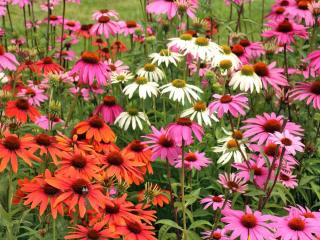

Echinacea, a perennial with colored flowers, also goes by the name “purple coneflower“.
Key Echinaceae facts
Name – Echinacea
Family – Asteraceae
Type – perennial
Height – 36 to 48 inches (90-120 cm)
Exposure – full sun
Soil: ordinary – Foliage: evergreen – Flowering: July to October
Purple coneflower blooms from summer to fall and it is simply beautiful. Take delight in these beautiful flowers that adapt to our climates so well. Care is so easy, it is perfect for beginners.
In spring in a sheltered spot and in full sun. Purple coneflower requires rather rich and well drained soil because it loathes having its roots dwell in water.
Particularly resilient to drought, feel very free to place it in a very hot and sun-bathed corner.
Easy to grow and care for, purple coneflower requires little attention and will bloom abundantly all summer long. A few good tips should help you increase the blooming still more.
Purple coneflower is a plant for which many health benefits have been recognized, and it is widely included in capsule preparations for herbalism.
From the purple coneflower, the root and the rest of the part are used for therapeutic purposes. Three varieties often come up for medicinal use: Echinacea angustifolia, Echinacea pallida and Echinacea purpurea.
Native to North America, and sometimes mistaken to be a daisy, echinacea will offer you beautiful flowers from summer to fall. This plant is part of same family as the aster.

Echinacea purpurea, a close cousin to rudbeckia, will bear leafage and flowers that will give your flower beds new colors, but there are many other colors and varieties.
Also, echinacea has medicinal properties that the Indians had discovered long ago, and which are still part today of many therapeutic solutions for them, and increasingly for the rest of the Western world, too.
Echinacea purpurea or angustifolia are both very much at ease in pots, and the result is often a great success.